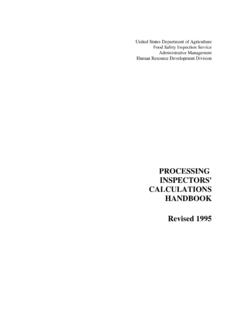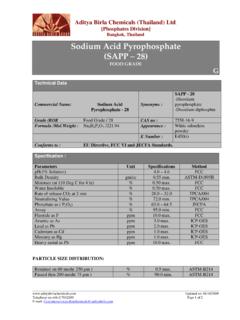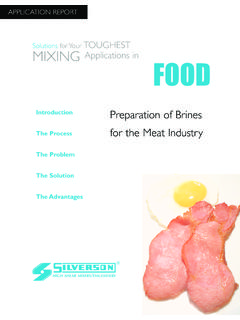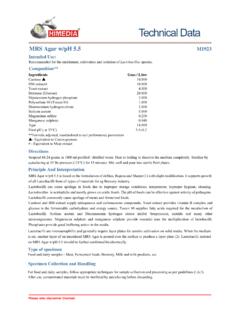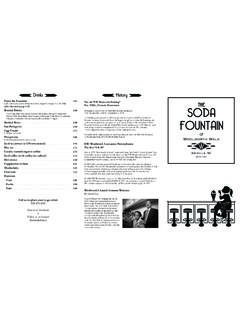Transcription of Do phosphates improve the seafood quality? …
1 Do phosphates improve the seafood quality ? reality and legislation ALEX AUGUSTO GON ALVES1 & JOS LUIS DUARTE RIBEIRO2. 1. Dr. is a post-doc researcher at Center of Water Reseources Studies, Dalhousie University, Halifax, NS, Canada 2. Dr. is a professor at Faculty of Engineering, UFRGS, Porto Alegre, Brazil Abstract: phosphates are natural components of almost all foods and are also used as functional food additives in food processing. In the seafood industry, phosphates have a wide application and are providing many functional uses. Consumers should be able to acquire seafood with as little loss of content and quality as possible. An appropriate treatment of the seafood with phosphates should be chosen carefully, based on the seafood species, product type and according to the consumer's expectations and international legislations. Moreover, phosphates cannot substitute an inadequate handling and cannot improve the quality of a poor product.
2 The conditions of the product and its quality should be evident and documented during the whole processing. Key words: seafood , phosphates , quality , legislation . Resumo. Os fosfatos melhoram a qualidade do pescado? Realidade e legisla o. Os fosfatos s o componentes naturais de quase todos os alimentos e tamb m s o utilizados como aditivos alimentares no processamento dos alimentos. Na ind stria do pescado, os fosfatos t m uma ampla aplica o e fornecem m ltiplos usos funcionais. Os consumidores devem adquirir pescado com pouca perda de conte do de gua e de qualidade, o m ximo poss vel. Um tratamento adequado do pescado, com fosfato deve ser cuidadosamente escolhido, com base na esp cie, tipo de produto e de acordo com as expectativas do consumidor e de legisla es internacionais. Al m disso, os fosfatos n o podem substituir um tratamento inadequado e n o pode melhorar a qualidade de um produto pobre. As condi es iniciais do produto e sua qualidade devem ser evidentes e documentadas durante todo o tratamento.
3 Palavras chave: pescado, fosfatos, qualidade, legisla o. Industrial Relevance appearance and little weight loss, mainly the frozen This review intend to show for researchers products (Gon alves 2004a, 2004b, 2005; Schnee and seafood industrials the potential use of additive 2004). phosphate in industrial applications; showing the Shortly after the capture, a series of importance of legislation and limit use. The complex alterations (biochemical and microbio- phosphates application in seafood is shown logical) occurs on the surface and inside the promising, but it has to be used with criterion. The edible portion of all seafood , resulting in a incorrect or abusive use will lead to sensorial decrease of its quality . Water is the most abundant failures and besides that, it can characterize component in its muscle, considering weight as economic frauds. well as volume (70-80%). As a main component, it influences the seafood sensorial attributes, its Introduction shelf life and quality .
4 However, a part of this seafood is very popular in the world, with water is lost during transportation, from its high nutritional value, what explains the high capture to its processing and posterior comer- demands on the part of the consumers. Besides, the cialization, through drip, evaporation and/or cooking growing costs of these products generate higher (Toldr 2003; Gon alves 2004a, 2004b). quality expectations. Consumers should be able to Thus, the seafood processing companies obtain seafood products of high quality , best have a great concern in retaining this water, first Pan-American Journal of Aquatic Sciences (2008) 3(3): 237-247. 238 A. A. GON ALVES & J. L. D. RIBEIRO. for economic reasons ( seafood is sold by weight) of the phosphoric acid with alkaline metallic ions and secondly, for the quality of the final product (sodium, potassium or calcium), two phosphate (Toldr 2003). On the other hand, an excessive classes are formed: orthophosphates and loss of water can generate a great dissatisfaction pyrophosphates (Dziezak 1990; Lampila 1992; Neto on the part of the consumers for the following & Nakamura 2003; WFM 2004).
5 Reasons: (a) the drip of the fish generates an The basic structures for the salts of undesirable appearance; (b) cooking reduces the phosphate are the orthophosphoric acids. The size of the fish; (c) and mainly, the loss of the salts formed by the reaction with a base, as sensorial attributes (juice, texture and color) makes the sodium hydroxide, are for that reason referred the seafood less attractive. to as orthophosphates, besides other salts of sodium which are also presented on Table 1, with Use of phosphates in seafood the common nomenclatures in the literature, as Aware of the loss of water during the well as the code International Number System capture and processing, the commercial practices for Food Additives - INS (Marujo 1988; Dziezak have been involving the control, addition (hydration) 1990; Teicher 1999; Neto & Nakamura 2003; WFM. and retention of the moisture of the fish during 2004). the capture, processing, distribution, storage and preparation.
6 The treatment of the fish Table 1. Phosphoric acid and sodium orthophos- with phosphates , to guarantee its quality , has phates. been used for many years. However, excessive Name INS. addition of water can lead to adulteration resulting Phosphoric Acid, Orthophosphoric Acid, 338. in economic fraud, while a limit of water and Monobasic Sodium phosphate (MSP). loss of water can endanger the quality , the shelf Monosodium phosphate , Monosodium 339i life and the acceptance of the product by Orthophosphate, Sodium Biphosphate the consumer (Schnee 2004; Garrido & Otwell Dibasic Sodium phosphate (DSP), Disodium 339ii 2004). phosphate , Disodium Orthophosphate Among the functional properties changed Tribasic Sodium phosphate (TSP), Trisodium 339iii phosphate , Trisodium Orthophosphate by the addition of phosphates in seafood and Source: Teicher (1999). its products are: (a) the retention of the moisture and natural flavor, inhibiting the loss of fluids during the distribution and the comer- When the orthophosphates are heated under cialization, (b) the emulsifying (mainly in sausage controlled conditions of pH, reactions occurs, or products), (c) the inhibition of the process of they condense forming the pyrophosphates or lipid oxidation (by the quelation of metallic ions), diphosphates.
7 If, under controlled conditions, higher (d) the stabilization of the color, and (e) the temperatures are used, it will promote the cryoprotection which contributes to the extension polymerization, producing the tripolyphosphates and of its shelf life (Neto & Nakamura, 2003; Schnee components of larger molecular weights. Table 2. 2004; nal et al. 2004). presents the additives more commonly used in the Recently, the use of phosphates in some processing of meats, chickens and seafood (Dziezak segments of the fishing industry has been object of 1990; Teicher 1999; WFM 2004). meticulous exam of the governmental institutions in Table 2. Sodium pyrophosphates and sodium poly- several countries, including Brazil. When used phosphates . inadequately, the excessive absorption of moisture Name INS. can lead to economic fraud accusation. However, when applied criteriously, the phosphates retain the Sodium Acid Pyrophosphate (SAPP), Dihydrogen Sodium Pyrophosphate, Dihydrogen natural moisture resulting in softer and succulent 450i Sodium Diphosphate, Disodium Pyrophosphate, products.
8 It is important to highlight that the Dibasic Sodium Pyrophosphate polyphosphates should never be used to mask an Tetrasodic Pyrophosphate (TSPP), Sodium inferior or deteriorated quality product (Aitken Pyrophosphate, Sodium Pyrophosphate 450iii 2001; Neto & Nakamura 2003). Tetrabasic, Sodium Diphosphate Sodium Tripolyphosphate (STP), Pentasodic, Classification and nomenclature 451i Sodium Triphosphate The phosphates are obtained by the refine of Sodium Hexametaphosphate (SHMP), Sodium 452i the calcium phosphates that occur naturally in the Polyphosphate, Sodium Metaphosphate mineral rocks. Through total or partial neutralization Source: Teicher (1999). Pan-American Journal of Aquatic Sciences (2008) 3(3): 237-247. Do phosphates improve the seafood quality ? 239. Physical and chemical properties and their more commonly used are pure Sodium Tripoly- functions phosphate (STP) or in mixtures with Sodium According to Marujo (1988), Food Chemi- Hexametaphosphate (SHMP) or Sodium Acid Pyro- cals Codex establishes the following specifications phosphate (SAPP) and/or Tetrasodic Pyrophosphate for the phosphates to be used in food: High degree (TSPP), because they show a combination of pro- of purity (variable according to the product), Arsenic perties, such as solubility, adjustment of the medium (maximum 3 ppm), Fluoride (maximum 50 ppm), pH and tolerance to the ions Mg2+ and Ca2+, frequen- Lead (maximum 5 ppm), Heavy metals (maximum tly present in the processing water.)
9 Some typical 10 ppm), Insolubles (maximum ). properties are summarized on Table 3 (Teichner In the seafood applications, the phosphates 1999; Neto & Nakamura 2003; nal et al. 2004). Table 3. Properties of the commonly used phosphates . Properties STP SHMP SAPP TSPP. pH (aqueous solution 1%, 25 C) 9,8 6,9 4,4 10,2. Solubility (g/100g; ) 13 > 60 13 6. P2O5 (%) 58 67 63 53. Total Na2O (%) 42 32 28 46. Source: Marujo (1988); Dziezak (1990); Teicher (1999). Hydration and water holding capacity around the proteins and, thus, larger amount of water According to FDA (1993), sodium can be kept within the proteins (Minatti 2004). tripolyphosphates are additives of the phosphate The effect of the phosphates in the retention family used in the seafood industry with a humectant and connection with the molecules of water is due to function, , those substances maintain the moisture a specific polianionic effect or to an alteration of the of the product, being more used in scallops, shrimp load of the muscle proteins.
10 That effect is only and lobsters processing. reached through a group of special phosphates called According to Detienne and Wicker (1999), "diphosphates", which make the proteins attract the interaction of the polyphosphates with the muscular molecules of water (Figure 1). tissue and the hydration and tenderization Mono Di- Tri- Polyphosphates mechanism of the meat, have not been completely understood. Some hypothetical factors discussed Buffering capacity among several researchers have shown that the actions of the polyphosphates in the muscular tissue Sequestering properties can happen due to (a) the increase of the pH of the meat, (b) the increase of the ionic force, (c) the Hydration (meat protein). quelation of metallic ions and (d) the dissociation of Poli nion characteristics the actomyosin complex. The water holding capacity (WHC) involves Figure 1. Chemical characteristics of the phosphates (Schnee, an interaction between the protein or the proteic 2004).
